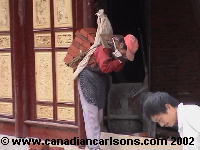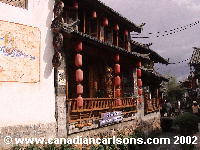| Lijiang (September 13th - September 16th, 2001) | ||
| Home Introduction Japan China Beijing Xi'an Dali Lijiang Guilin/ Yangshuo Hong Kong
Singapore |
We took the mini bus to Lijiang. It was quite crowded, but we made good
time, arriving in about 3 hours. I would have enjoyed the scenery more if the hillside roads had
guardrails.
Lijiang is the closest that we would get to Tibet. Unfortunately, it was cloudy the entire time we were there, so we did not see the mountains - or more particularly Jade Dragon Snow Mountain which soars 5500m above the city. Lijiang has been hit with a two major earthquakes in the past 5 years. Apparently the new architecture suffered much more than the traditional wood beam buildings. Given the chance to rebuild, China decided to create an 'old style' village. It has been so successful that it is a UNESCO world heritage site. There are about 300,000 Naxi minority - and it would appear that many live in the Old Town of Lijiang. Work carries on in the traditional way and, other than the souvenir shops, staged photo ops, and restaurants with western food, life is probably similar to what it was in ages past. Our first day we spent wandering around the village. All the streets are rough cobble stones. There is no vehicle traffic except for a miniature garbage truck that played music that sounded like a Dickie Dee Ice Cream truck - the kids were disappointed when they found out what it really was. Mark learned about stinging nettles when we were taking a 'shortcut' back to the village from the pagoda on the hill (Wanggu Lou). Luckily Sarah recognized Dock leaves, which are the antidote to the sting, so Mark returned to normal after a few minutes. Heather developed a skin rash - we think they are hives from an unwashed pear in a pear milk shake she had drank that morning. We went to a local pharmacy and through a game of charades (and showing the rash) managed to buy a cream and pills that they thought would work. Amazingly, the rash was almost entirely gone by the next morning for a total pharmacy cost of under $10. Included in the $10 were some cough suppressants for Chloe who seems to have her terrible cough back - perhaps asthma from the air pollution. Water flows almost everywhere - ditches, culverts, canals run through and around most houses in the old town. We have seen people washing clothes in it, throwing buckets in to get water for washing restaurant pots and pans (we avoided those establishments), floors, etc. Of course, water is used by all humans, but here in Lijiang, it just seems to be more 'in your face'. Actually I think this is probably a fair comment about China in general: rice fields are all individually dammed to allow the fields to be flooded for rice production; drainage ditches and aqua ducts run all over. Water is worked quite hard in China. On the second day, we walked to the Black Dragon Pool - a picturesque park at the head of the river flowing into Lijiang. We did not go to Tiger Leaping Gorge or Jade Snow mountain. We decided the weather was just not good enough to go up the mountain, and Tiger Leaping Gorge looked a bit too arduous a trek to do with kids. We caught a plane to Kunming and changed planes for a flight to Guilin - for the first time in China, neither flight left on time. We arrived in Guilin at about 8:30 p.m., about 3 hours later than we were supposed to. |


